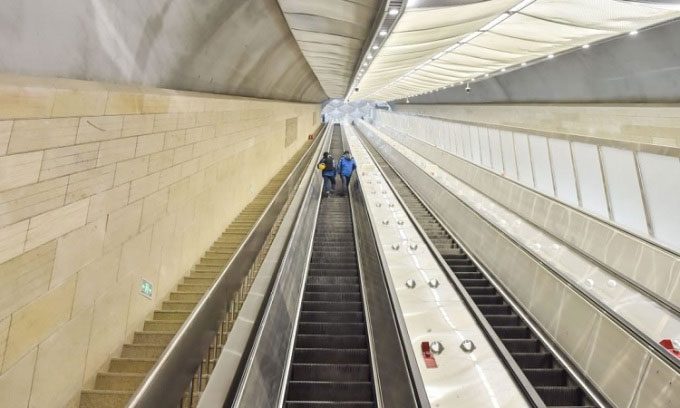The Badaling Great Wall Station is located 102 meters beneath the Great Wall and is considered a modern engineering marvel.
With the 2022 Beijing Winter Olympics approaching, the world’s first fully autonomous high-speed train has begun operations, transporting athletes and officials between the two main cities hosting events along the intercity railway from Beijing to Zhangjiakou. The bullet train’s autonomous capabilities are already remarkable. However, a portion of the 56-minute journey traverses another engineering wonder: the Badaling Great Wall Station.

Elevator leading down to Badaling Great Wall Station. (Photo: CNN).
Completed in 2019, the station is located not far from the entrance to Badaling, the most famous section of the ancient wall. To protect this iconic structure from structural damage, the railway and accompanying station were constructed deep underground. Situated at a depth of 102 meters and covering an area of over 36,000 m2, this three-story facility is the world’s deepest and largest underground high-speed railway station.
Building such a complex station with a 12-kilometer tunnel beneath a UNESCO World Heritage site is no easy task. Engineers utilized electric detonators to time explosions to the millisecond. This technology was used for the first time in China, allowing workers to maintain vibration levels below 0.2 cm/second. This means that each explosion was precisely calculated to ensure that the impact was no greater than a footstep on the Great Wall.
Starting in 2016, the tunnel and station construction was completed in three years. The high-speed railway reduces travel time from Beijing to Badaling Great Wall from about 1.5 hours (or longer in traffic) to just 27 minutes. The station is only a few minutes’ walk from the Great Wall cable car station and approximately 800 meters from the starting point of Badaling. It is also home to the second-longest elevator in China, measuring 88 meters long and 42 meters high.
Due to the distance to the platform, the station gates close 12 minutes before the departure of the last train, compared to 5 minutes at other stations in China, ensuring passengers have enough time to navigate the expansive station.
Operating on the Beijing-Zhangjiakou railway, which is 174 kilometers long, is the Fuxing multiple-unit high-speed train developed by the China Railway Group. Launched in early January, the train can travel at speeds of up to 350 km/h, reducing travel time between the two Olympic cities from 3 hours to just 56 minutes.
Although the high-speed train operates autonomously, a driver is always on standby. The train can initiate departures, stop, and adjust according to varying speed limits between stations. Each of the train’s eight cars is equipped with 5G signaling, smart lighting systems, and 2,718 sensors to collect real-time data and detect any issues during operation. Special cars are designed according to the needs of athletes. For example, some cars have larger storage areas for winter sports equipment, accessible via QR code scanning.





















































